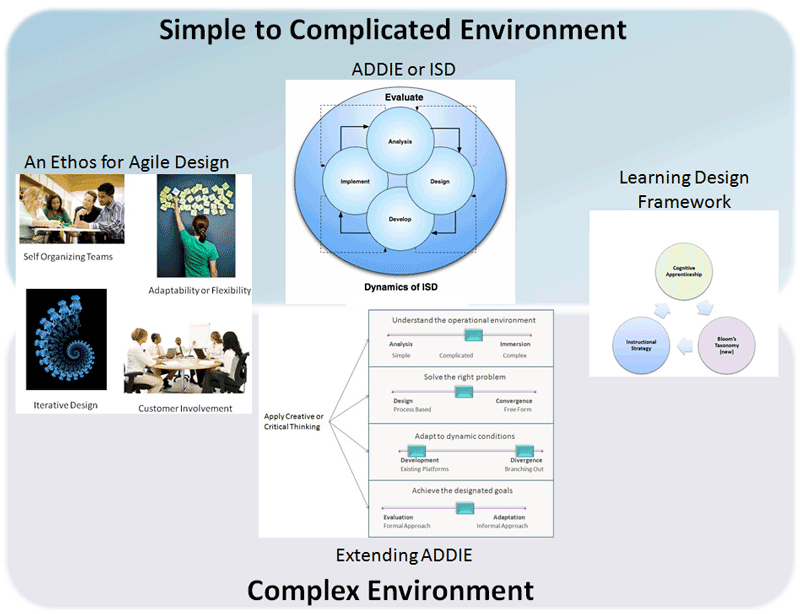What Does the "A" in KSA Really Mean?
Does the “A” in KSA mean attitude or ability?
Attitudes
Bela Banathy (1968, pp 24-26) uses the term “attitudes” in his book:
We can say that the purpose of education is to impart specific knowledge, skills, and attitudes—in other words, the purpose around which the system is to grow is instruction. On the other hand, we can propose that the purpose of education is to ensure the attainment of specified knowledge, skills, and attitudes—thus, learning, is the purpose around which the system is to grow.
He then goes on to propose that learning is the nucleus of a training or educational system rather than instruction.
In the Department of Defense Handbook, A System Approach to Training (1988), the terms knowledge, skills, and attitude are used. They list the learning levels for attitude (p52):
- Receiving
- Responding
- Valuing (Judgment)
- Competence
- Innovation
Knowledge, skills, and attitudes relate directly to Bloom's Taxonomy of Cognitive, Affective, Psychomotor (Laird, 1985, p107):
- Cognitive - Knowledge
- Affective - Attitude
- Psychomotor - Skills
The first taxonomy, cognitive, appeared in 1956 (Bloom). The second, affective, appeared in 1973 (Krathwohl). While the third, psychomotor, was published in 1972 (Harrow).
Robert Gagne (1972) developed five categories of learning:
- verbal information
- intellectual skill
- cognitive strategy
- attitude
- motor skill
He argued that the mental processing required for the first three was different enough that there should be five, rather than three categories. Notice the intellectual skill in his five categories—I will refer to this shortly as “intelligence.”
However, perhaps the first mention of tying the three KSAs together is in a book edited by Robert Gagne. In chapter nine, Concepts of Training, Meredith Crawford (1962) describes how the course objectives are dependent upon the accuracy of the determination of knowledge and skills. And as the training progresses, the learners form attitudes about:
- The training program
- The knowledge and skills they are expected to acquire
- The parent organization
Abilities
The Department of Energy handbook (1994), uses Knowledge, Skills, and Abilities.
In Human Resource Development (2012), the authors, Randy Desimone and Jon Werner use the term “abilities” (p. 61-62). They define abilities as general capacities related to the performance of a set of tasks. They develop over time through the interaction of heredity and experience. While “skills” are similar to abilities but differ in that they combine abilities with capabilities that are developed as a result of training and experience. They go on to define knowledge as an understanding of factors or principles related to a particular subject. It seems to me that abilities are really the “informal” version of “skills” — sort of like informal learning and formal learning. So if we follow this line of reasoning, then rather than having just three, perhaps we should have four: knowledge (formal), intelligence (informal), abilities (informal), and skills (formal); or for short — KIAS. In addition, the authors write (p. 60) that it is KSAs, attitudes, and motivation that influence employee behavior. Thus if we take the above one step further, then perhaps it should be knowledge (formal cognitive), intelligence (informal cognitive), abilities (informal psychomotor), skills (formal psychomotor), attitudes (formal affective), and motivation (informal affective); or for short — KIASAM.
Attitude vs. Ability
Miguel Quinones and Addie Ehrenstein (1997) use the term “ability.” However, they point out a distinction that should help us with our understanding of why the acronym has two different meanings. They distinguish between instructional objective and learning outcomes. (pp 155-157). Instructional objectives act a link between the results of a needs assessment and the design of training. They describe the job performance required by the learners, thus perhaps ability, rather than attitude, makes more sense when used in this context.
On the other hand, learning outcomes link the design of training to the selection of instructional strategies. They reflect the educational and training goals of the designers and are derived from the learning objectives. And when formulating instructional or learning strategies, you normally have refer to a taxonomy, such as Bloom, Krathwohl, and Harrow's Cognitive, Psychomotor, and Affective domains. Thus, attitude starts to make more sense when used in this context.
Conclusion
From my understanding, it seems that the “A” in KSA originally meant “attitude.” It then became politically correct to use “ability” rather than “attitude” as it was deemed incorrect to change someone's attitude if they behaved correctly. While our profession was at one time almost completely dominated with behaviorism, we now have far greater perspectives to draw from, thus we need to look beyond just behavior as a present correct behavior does not always equal a correct future behavior. For example, when speaking of safety, it is just as important to have the correct attitude as it is to have the correct knowledge and skills. That is, when I go to work in a warehouse full of heavy equipment, I want my fellow partners to display not only the correct behavior, but to also have an attitude towards safety. My ability to come home in one piece depends upon it!
When viewing the “A” from the performance side of training, then perhaps “abilities” makes more sense. However, when viewing the “A” from the strategy side, then perhaps “attitude” works better.
References
Bloom B. S. (1956). Taxonomy of Educational Objectives, Handbook I: The Cognitive Domain. New York: David McKay Co Inc.
Banathy, B. (1968). Instructional Systems. Palo Alto, California: Fearon Publishers.
Department of Defense Handbook (1988). Instructional System Development/ System Approach to Training and Education (part 2 of 5). MIL-HDBK-29613-2A. 31 Oct 1988.
Department of Energy handbook (1994). A System Approach to Training. DOE-HDBK-1078-94, Aug 1994.
DeSimone, R. L., Werner, J. M. (2012). Human Resource Development. Mason, OH.: South-Western College Pub.
Crawford, M. (1962). Psychological Principles in System Development. Robert M. Gagne (ed). New York: Holt, Rinehart and Winston, Inc.
Gagne, R. M. (1972). Domains of learning. Interchange, 3(1) 1-8.
Harrow, A. (1972). A Taxonomy of Psychomotor Domain: A Guide for Developing Behavioral Objectives. New York: David McKay.
Krathwohl, D. R., Bloom, B. S., & Masia, B. B. (1973). Taxonomy of Educational Objectives, the Classification of Educational Goals. Handbook II: Affective Domain. New York: David McKay Co., Inc.
Laird, Dugan (1985). Approaches To Training And Development. Reading, MA: Addison-Wesley, p107.



